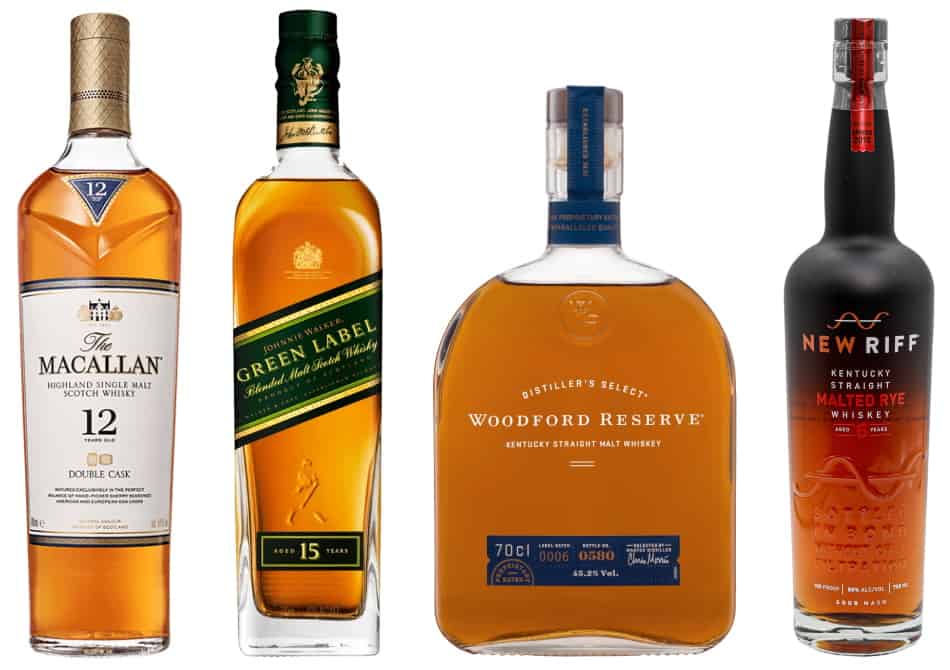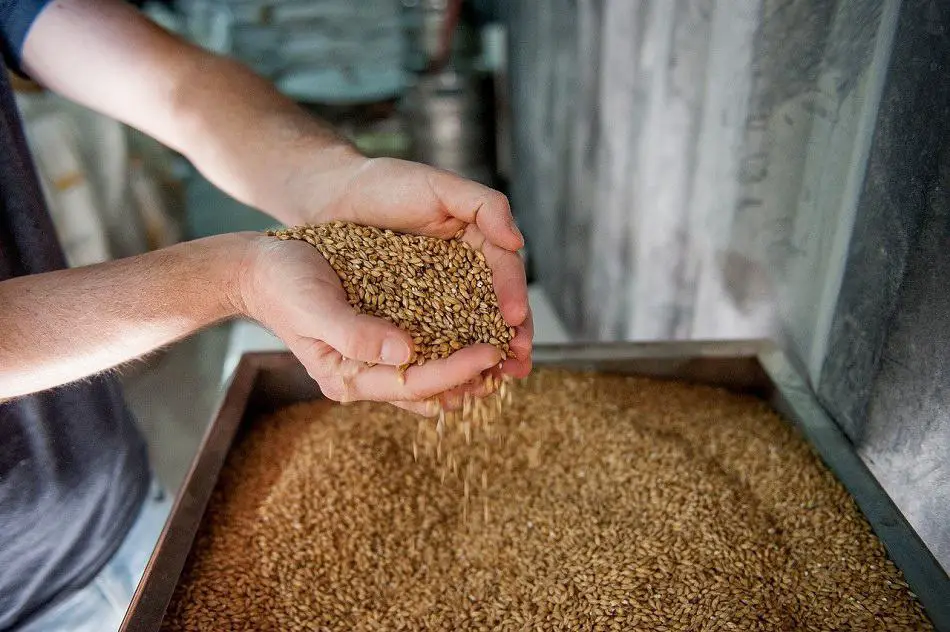Malt whiskeys are considered by many to be better than other types of whiskey and often they are. However, there are actually several types of malt whiskey and when you pay attention to their differences, it becomes clear that some of them contributed to this reputation more than others. So here are the four types of malt whiskey and their differences.
For a great deal on malt whiskeys visit saucey.com and use PROMO Code SAS to get $5 Off Your First Order AND Free Delivery
and use PROMO Code SAS to get $5 Off Your First Order AND Free Delivery

1. Single Malt Whiskey
Single malt whiskey has two basic criteria:
- It must be made from malted barley only.
- It must come from one distillery.
Distillate produced by malted barley has a better flavor profile than the distillate produced by other grains, even if they’re malted. It’s sweet and tastes of caramel, toffee and brown sugar. That’s one of the reasons why malt whiskeys are often better than other whiskeys.
Several countries produce single malt whiskey and while they all have the same above-mentioned basic criteria in common, there are some important differences between them.
Single Malt Scotch Whisky
Single malt Scotch whisky must be distilled in pot stills. Pot stills produce a more flavored distillate than column stills, and it allows for several different designs which distilleries can use to affect the whiskey’s flavors. This is another reason why malt whiskeys are often better than other whiskeys.
Single malt Scotches are often peated, which means that peat was used to fuel the kiln when drying the barley during the malting process. It’s what gives peated whiskies their smoky peaty flavor.
They must also meet all the general criteria for being a Scotch whisky:
- They must be made in Scotland.
- They must be aged in used oak barrels.
- They must be aged for at least three years.
- They must be bottled at a minimum of 40%ABV.
Single Malt Irish Whiskey
Single malt Irish whiskey must also be distilled in pot stills. They’re usually distilled three times (most whiskeys are only distilled twice) which is why they’re so smooth, and they’re usually not peated.
They must also meet all the general criteria for being an Irish whiskey, which is almost exactly the same as those for Scotch whisky:
- They must be made in Ireland.
- They must be aged in used oak barrels.
- They must be aged for at least three years.
- They must be bottled at a minimum of 40%ABV.
Single Malt American Whiskey
There is as the moment no legal definition for single malt American whiskey and technically, an American whiskey can be labelled as single malt even if it’s made from as little as 51% malted barley (this is actually American malt whiskey – see number 3).
However, many single malt American whiskeys do adhere to the basic criteria for single malts and are made with malted barley only and come from one distillery.
But they don’t have to be distilled in pot stills and they do have to meet all the general criteria for being an American whiskey which, being sometimes exactly the opposite (in bold) to those of Scotch whisky and Irish whiskey, can make them very different:
- They must be made in America.
- They must be aged in new, charred oak barrels.
- There is no legal minimum aging period.
- They must be bottled at a minimum of 40%ABV.
Single Malt Japanese Whisky
There’s also no legal definition for single malt Japanese whisky, but since their industry’s pioneers modelled their product on Scotch whisky they typically follow the same criteria. They’re usually made from malted barley only, come from one distillery and distilled in pot stills.
Some examples of single malt whiskey (and the countries they’re from) are:
- The Macallan 12 Year Old Double Cask (single malt Scotch whisky)
- The Glenlivet 18 Year Old (single malt Scotch whisky)
- Highland Park 18 Year Old (single malt Scotch whisky)
- Bushmills 10 Year Old (single malt Irish whiskey)
- Teeling (single malt Irish whiskey)
- Tullamore D.E.W. 14 Year (single malt Irish whiskey)
- Copperworks (single malt American whiskey)
- Balcones Texas “1” (single malt American whiskey)
- Westward American Oak (single malt American whiskey)
- Nikka Yoichi 15 Year old (single malt Japanese whisky)
- The Yamazaki 12 Year Old (single malt Japanese whisky)
- The Hakushu 18 Year (single malt Japanese whisky)

2. Blended Malt Whiskey
Blended malt whiskey is a mixture of two or more single malt whiskeys from different distilleries. This should not be confused with blended whiskey which is a mixture of malt and grain whiskeys.
Since malt whiskeys are often better than other types of whiskey, you can understand the importance of making this distinction.
Any differences between blended malt whiskeys from different countries will be the same as the differences between their single malts.
Some examples of blended malt whiskey (and the countries they’re from) are:
- The Naked Grouse (blended malt Scotch whisky)
- Monkey Shoulder (blended malt Scotch whisky)
- Johnnie Walker Green Label 15 Year Old (blended malt Scotch whisky)
- Big Peat (blended malt Scotch whisky)
- Lambay (blended malt Irish whiskey)
- Nikka Taketsuru 17 Year Old (blended malt Japanese whisky)
- The Kurayoshi 8 Year Old (blended malt Japanese whisky)
- The Shinobu 10 Year Old (blended malt Japanese whisky)
3. American Malt Whiskey
American malt whiskey must be made from at least 51% malted barley. The rest of the mashbill may contain any other grain or grains, for example corn or rye, that can be malted or unmalted.
This follows the style of most American whiskeys in that they have to be made with a given percentage of a particular grain (usually at least 51%).
- Bourbon is made from at least 51% corn.
- Corn whiskey is made from at least 80% corn.
- Rye whiskey is made from at least 51% rye.
- Wheat whiskey is made from at least 51% wheat.
As you will have probably noticed, since American malt whiskey does not have to be made from 100% malted barley and single malt American whiskeys are not yet legally defined, there’s lots of room for confusion. American malt whiskey made from only 51% malted barley can be labelled as single malt and single malt American whiskey doesn’t have to be made from 100% malted barley.
This also means that some American malt whiskeys will be close to being a single malt whiskey while others will be closer to being another type of whiskey. If it’s made with 100% malted barley then it will be a single malt whiskey but if it’s made from 51% malted barley and say 49% corn then it will be closer to being a bourbon.
American malt whiskeys must also meet all the above-mentioned general criteria for being an American whiskey.
Some examples of American malt whiskey (and their mashbills) are:
- Woodford Reserve Kentucky Straight Malt Whiskey (51% malted barley, 47% corn, 2% rye)
- St. George Baller Single Malt Whiskey (mostly malted barley the rest lightly roasted barley)
- Ironweed Straight Malt Whiskey (60% malted barley, 20% wheat, 20% oat)
- CopperMuse Straight Malt Whiskey (barley, rye)
- Sawatch American Malt Whiskey (77% malted barley, 13% malted rye, 10% malted wheat)
4. American Rye Malt Whiskey
Most cereal grains can be malted, but usually only barley is. That’s because as mentioned earlier, it produces a distillate with a better flavor profile than other malted grains but it’s also because it germinates easily and when it does so, produces lots of the enzyme used for converting starches to sugars during the whiskey making process.
That’s why the phrase ‘malt whiskey’, when it’s unqualified, means malted barley, even if there’s another malted grain in the mashbill. In Scotland and Ireland, malt whisky cannot legally mean anything but whisky made from malted barley.
However, America does produce a whiskey from a malted grain that’s not barley. American rye malt whiskey must be made from at least 51% malted rye.
American rye malt whiskey should not be confused with American malt whiskey that must be made from at least 51% malted barley, or American rye whiskey that must be made from at least 51% unmalted rye.
American rye malt whiskeys must also meet all the above-mentioned general criteria for being an American whiskey.
Some examples of American rye malt whiskey are:
- New Riff Kentucky Straight Malted Rye Whiskey
- Corsair Dark Rye American Rye Malt Whiskey
- Resurgens Rye Malt Whiskey
- Rogue Oregon Rye Malt Whiskey
- Ironton Rye Malt Whiskey
- Old Maysville Club Rye Malt Whiskey
If your interested in malt whiskey, Tipxy.com have a great selection, which you can check out here (affiliate link)
(affiliate link)
